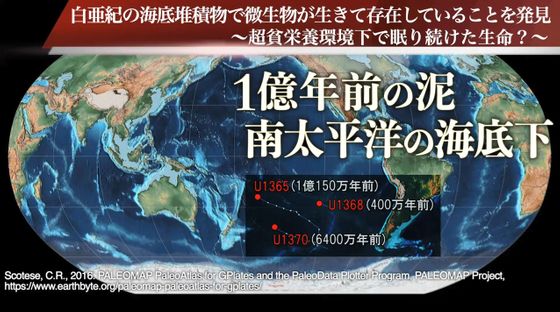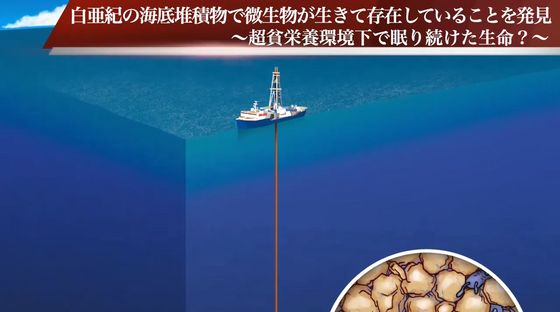Live microorganisms are discovered from the stratum 100 million years ago

About 70% of the earth's surface is covered by the ocean, and sediments from ancient times form the stratum on the seabed. Scientists are conducting research on the ocean floor ecosystem, past climate,
Aerobic microbial life persists in oxic marine sediment as old as 101.5 million years | Nature Communications
https://www.nature.com/articles/s41467-020-17330-1
Discovery of Microorganisms Living in Cretaceous Seafloor Sediments-Life that slept in a super oligotrophic environment? ~[Press Release [JAMSTEC | JAMSTEC
http://www.jamstec.go.jp/j/about/press_release/20200729/
Deep sea microbes dormant for 100 million years are hungry and ready to multiply
https://phys.org/news/2020-07-deep-sea-microbes-dormant-million.html

On the seabed, various dust and particles carried by the ocean current are deposited, and organic matter such as plankton emissions and carcasses are also accumulated as marine snow . Microorganisms are also contained in the sedimentary layer on the seabed, but these microorganisms cannot move freely inside the sedimentary layer composed of fine particles, and the microorganisms at the time when the stratum was formed are confined as they are. It is said that.
A research team led by JAMSTEC Senior Researcher Yuki Morono boarded JOIDES Resolution , a deep-sea drilling vessel for research, drilled a sedimentary layer in the waters called the South Pacific reflux region, and analyzed the collected samples. .. 'Our main question was whether life could or could not exist in a nutrient-restricted environment,' said Morono.
This is a movie that Mr. Morono explains in Japanese about this discovery.
Discover live microorganisms from the formation 100 million years ago! JAMSTEC Yuki Morono, Senior Researcher-YouTube
'I would like to talk about the research results of 'discovering living microorganisms in the stratum 100 million years ago',' says Morono.

Speaking of 100 million years ago, dinosaurs existed on Earth, and of course humans do not exist.

Most of the organisms 100 million years ago are usually found as fossils in the strata, but this time it was discovered that they were alive and able to multiply.

On land, the stratum deposited 100 million years ago becomes hard rock, but the stratum 100 million years ago is deposited as soft mud on the sea floor of the South Pacific, Morono points out.

This time, the research team collected sediments in the South Pacific return region between New Zealand and South America. Since this sea area is far from the land, it is known to have the lowest organic matter production in the sea water and the highest transparency of sea water on the earth.

The research team uses JOIDES and resolution...

Sediments were collected from the sedimentary layer, which is about 3740m to 5695m deep in the South Pacific reflux region and about 100m deeper than the seabed surface. In the sediment layer deep inside the seabed, microorganisms at the time of deposition are trapped in a sediment composed of fine particles.

And to investigate whether the microorganisms trapped in the sediment are alive, the research team conducted an experiment to culture the microorganisms by feeding

Initially, the research team predicted that 'microorganisms are on the verge of living or dying even if they exist, so they will not be easily revived.'

However, after culturing for 21 days to a year and a half, it was surprisingly found that living microorganisms were also present in the sediment formed 101.5 million years ago. On the 21st day from the start of culture, the microorganisms had taken in food, and after that the number of microorganisms had grown. In addition, it seems that microorganisms hardly took up food unless oxygen was added during the culture, suggesting that aerobic microorganisms that require oxygen for growth have survived in this sedimentary layer.

In addition, the research team calculated the ratio of 'microorganisms that were alive from the time they were trapped to the present day' that existed in the original sediment, based on the ratio of the microorganisms that took in food and the subsequent growth. As a result, it was revealed that up to 99.1% of the microorganisms survived from that time even in the stratum that accumulated 101.5 million years ago.

However, it is thought that the microorganisms would normally die because the stratum of 101.5 million years ago where the microorganisms were confined was a super- oligotrophic environment with little food. It seems that it is not known in detail why the microorganisms were able to survive, and Mr. Morono said that he would like to continue research.

Related Posts:







